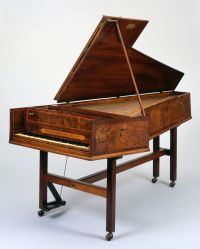Harpsichord
Artist/Maker: Jacob Kirckman (1710-1792)
Created: 1762
Origin/Purchase: London
Materials: mahogany, mahogany veneer
Dimensions: 89.8 × 92.7 × 218.4 (35 3/8 × 36 1/2 × 86 in.
Provenance: Pelham Galleries; by purchase to Patricia M. Kluge; gift to the Thomas Jefferson Foundation in 1990
Accession Number: 1990-13
Historical Notes: In 1786, Jefferson advised John Paradise, an old friend from Williamsburg then in London, "to get Kirkman to make for me one of his best harpsichords with a double set of keys, and the machine on the top resembling a Venetian blind for giving a swell."[1] This superb harpsichord, made by the celebrated London maker Jacob Kirckman (also spelled Kirkman or Kirckmann), was one of the finest harpsichords available at the time. It was acquired for his older daughter, Martha, while she was a student at the Abbaye de Panthemont. Evidently pleased with the first harpsichord, a second one, made by Joseph Kirckman, successor to Jacob and Abraham, was ordered for younger daughter Maria in 1798.
Although the pianoforte was solidly gaining acceptance, Jefferson remained steadfastly loyal to the harpsichord during its declining popularity. He wanted, however, to improve upon the plucked sound of the harpsichord. He specified that Martha's harpsichord was to have a patented "Celestina stop" by Adam Walker, a mechanism of revolving silk bands that added a bowed-string sound, as well as a Venetian swell for crescendos.[2] Dr. Charles Burney (1726-1814), the famous organist and musical historian whom Jefferson had briefly met earlier that spring, acted as his intermediary with Jacob Kirckman. Burney reported that Kirckman had no objection to the Venetian swell, but was "a great enemy" to the Celestina, believing that
the Resin, used on the silk thread that produces the tone, not only clogs the wheels and occasions it to be frequently out of order; but in a short time, adheres so much to the strings as to destroy the tone of the instrument.[3]
Against Kirckman's wishes, the Celestina stop was installed.
Jefferson also wanted an exceptionally durable harpsichord that was easy to tune and maintain. Burney wrote Jefferson that Kirckman reported that "he has sent Harpsichords to every part of the Globe where the English have any commerce, and never has heard of the wood-work giving way."[4]
After the family returned to Monticello, Martha's instrument was placed in the Parlor beneath the pier mirror on the southeast wall. Jefferson, advocating three hours per day of practice, was a great stimulus to his daughters and granddaughters. In 1790, he reminded Martha, "Do not neglect your music. It will be a companion which will sweeten many hours of life to you."[5] By 1825 the once prized harpsichord was in terrible condition, and one granddaughter stated that it was "an old instrument too far gone even to learn on."[6] Martha's harpsichord was left at Monticello after Jefferson's death, and reportedly was made into furniture. John Wayles Eppes, Maria's widower, returned her harpsichord (unlocated) to Poplar Forest in 1820 for Martha and her daughters to enjoy there.
Jacob Kirckman, the maker of the first instrument, worked for Hermann Tabel, a Flemish harpsichord maker in London. After Tabel's death, Kirckman married his widow and took over his business.[7] In 1772 Jacob entered into a partnership with his nephew, Abraham. They were succeeded by Joseph Kirckman after 1790. Although thousands of Kirckman harpsichords were made, only about 110 are known today. The harpsichord exhibited at Monticello, inscribed "Jacobus Kirckman Londini Fecit 1762," is a single manual instrument.
- Text from Stein, Worlds, 425
References
- ^ Jefferson to Paradise, May 25, 1786, in PTJ, 9:579. Transcription available at Founders Online.
- ^ See Lucia C. Stanton, Spring Dinner at Monticello, April 12, 1991 (Monticello Keepsakes 49) (Charlottesville: Thomas Jefferson Memorial Foundation, 1991), 4. See also Jefferson to Francis Hopkinson, May 9, 1786, in PTJ, 9:482-83. Transcription available at Founders Online.
- ^ Paradise to Jefferson, June 27, 1786, with Enclosure, Burney to Paradise, June 19, 1786, in PTJ, 10:75-76. Transcription available at Founders Online.
- ^ Ibid.
- ^ Jefferson to Martha Jefferson Randolph, April 4, 1790, in PTJ, 16:300. Transcription available at Founders Online.
- ^ Virginia Randolph Trist to Ellen Randolph Coolidge, September 3, 1825, Edgehill-Randolph Papers, Special Collections, University of Virginia Library.
- ^ For a good account of Kirckman's activity and his instruments, see Donald H. Boalch, Makers of the Harpsichord and Clavichord, 1440-1840 (Oxford: Clarendon Press, 1974), 84-95.

